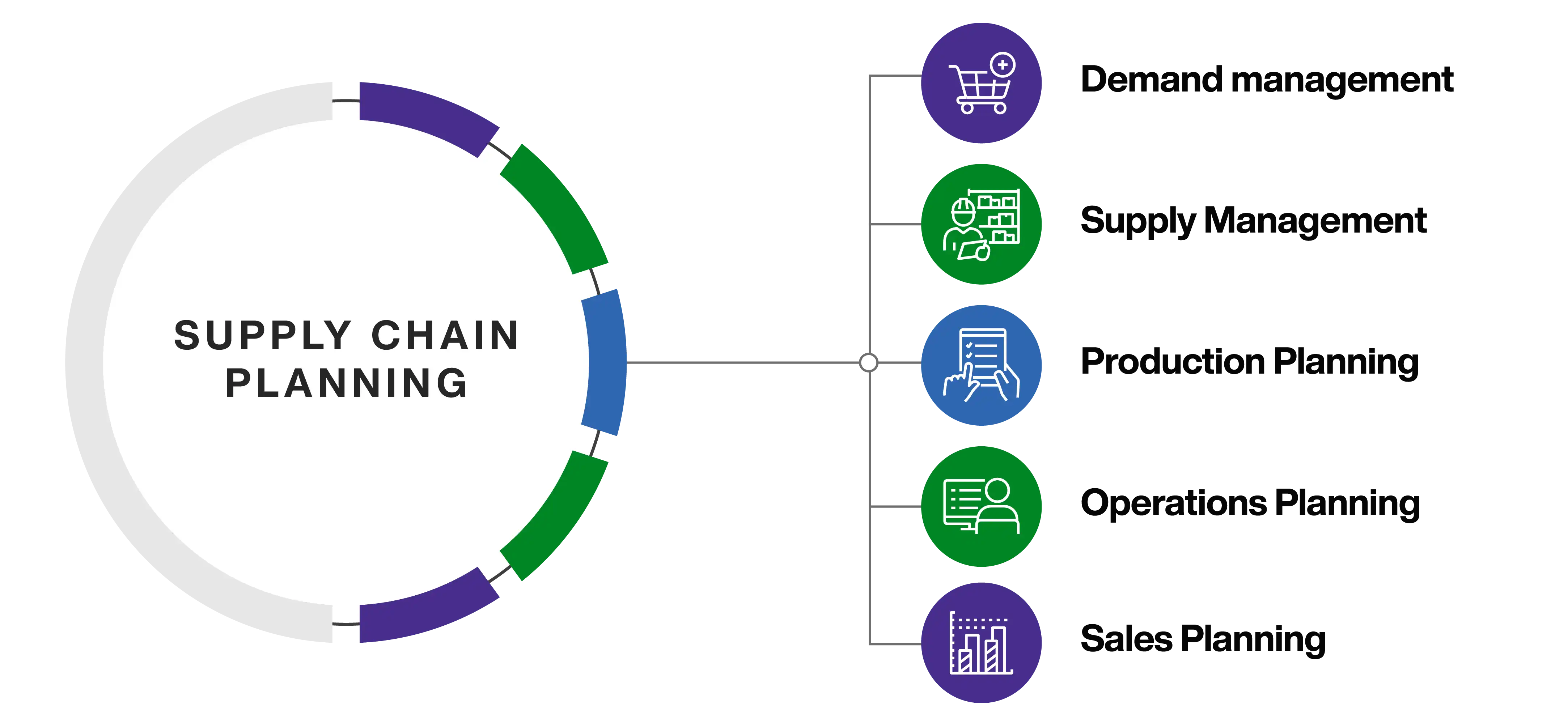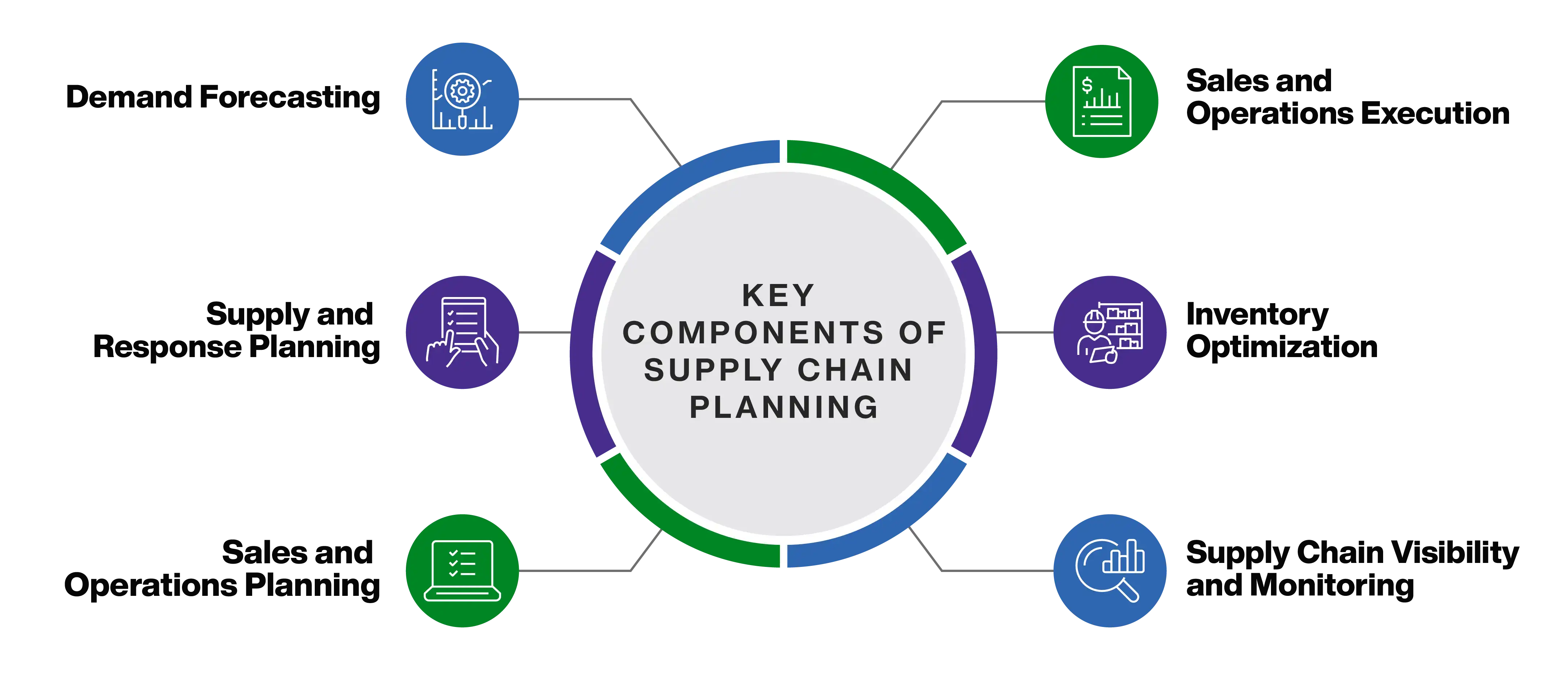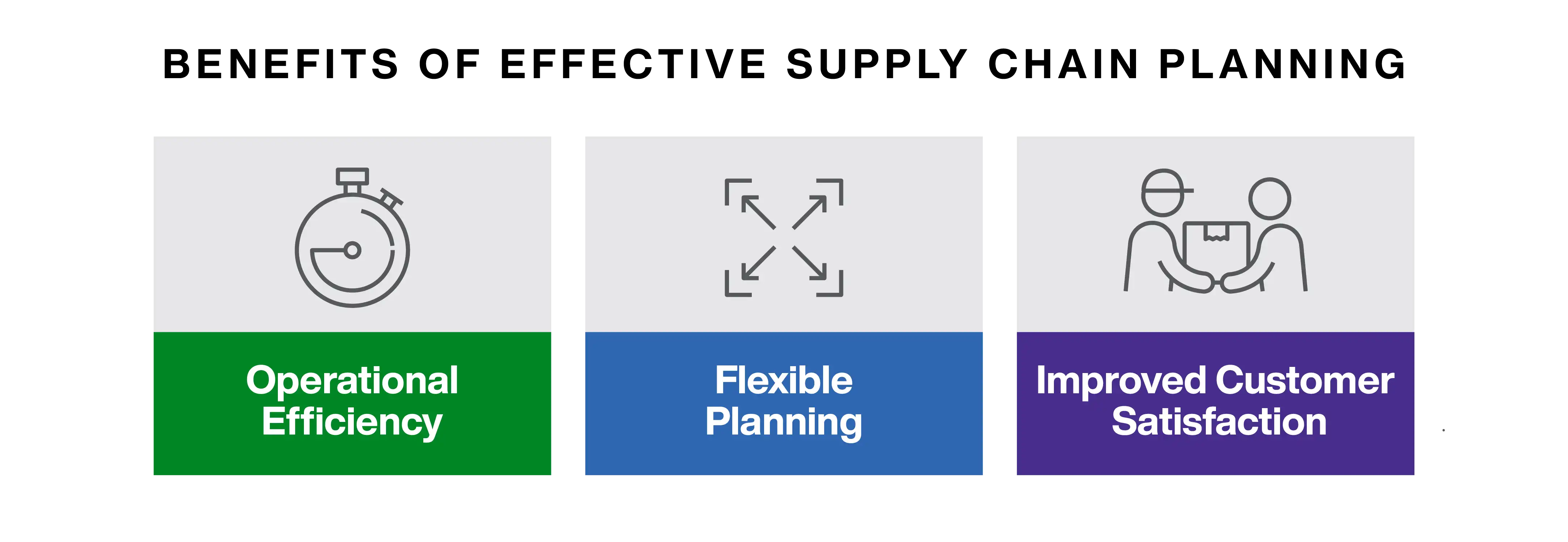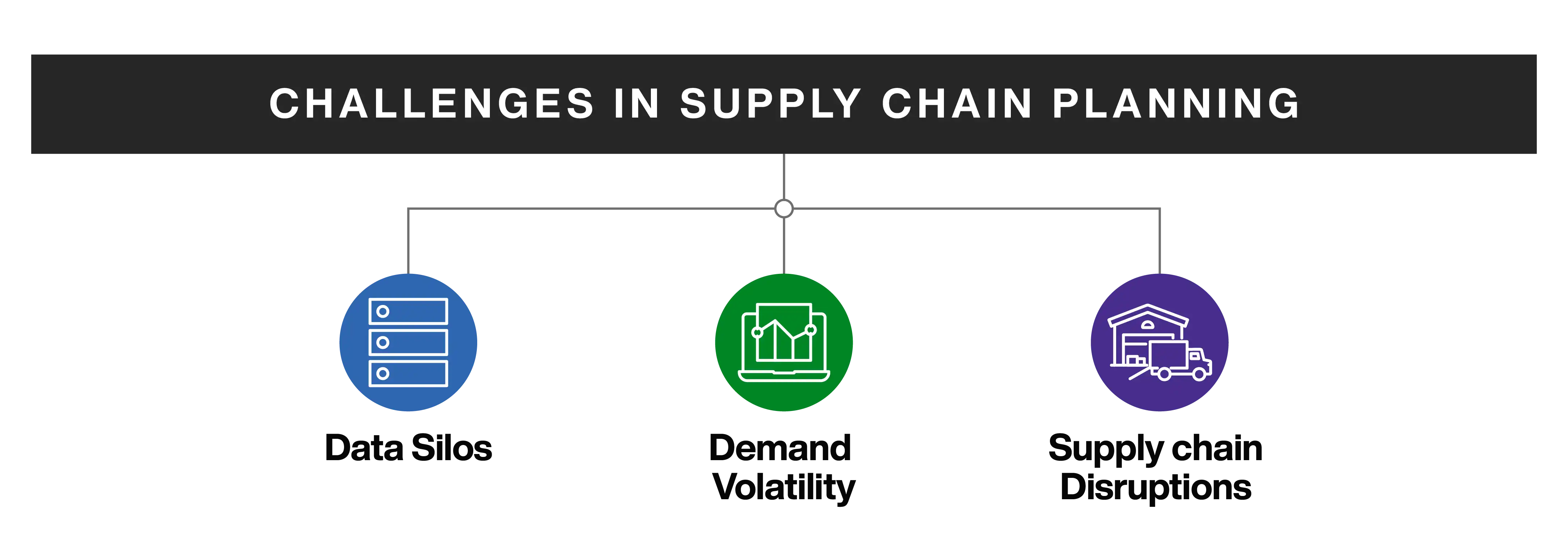
Supply Chain Planning: The Ultimate Guide for a Unified Supply Chain
Supply chain planning is the process of coordinating and optimizing the flow of raw materials and goods from manufacturers to suppliers to customers. It involves predicting how much demand there will be, planning for the right amount of materials, and managing production, distribution, and sales. Discover what supply chain planning is, its challenges, components, and its vitality to the full supply chain.
Supply Chain Planning: The Ultimate Guide for a Unified Supply Chain
What is Supply Chain Planning?
Good supply chain planning facilitates the transformation of raw materials to finished products, all while aligning supply with customer demand. It helps predict product needs, manage stock levels, and organize production to deliver on time without waste or extra costs.
At a time when disruptions like shortages, shipping delays, and sudden demand spikes are increasingly common, having a strong plan is essential for staying competitive and keeping customers happy. 
Key Components of Supply Chain Planning
Supply chain planning isn’t just a logistical challenge; it’s a layered strategy that holistically envelops demand forecasting, inventory management, and sales operations so that the right products get to the right places at the right times.
Demand Forecasting
Demand forecasting means looking at past sales, market trends and seasonal factors in order to predict how much product will be ordered. For example, a retailer might look at last year’s holiday sales data to figure out how many winter coats to stock for the upcoming Christmas season. As omnichannel commerce has exploded – and fulfillment options with it – tracking demand and where demand signals came from is increasingly difficult.
Supply and Response Planning
Supply planning leverages these demand forecasts and strategizes for sourcing, production scheduling, and inventory management.
Sourcing involves choosing the right suppliers, negotiating deals, and deciding how much to order and when. Production scheduling makes sure manufacturing aligns with demand, like increasing the production of sunscreen in the months leading up to summer. Finally, inventory management balances stock levels to prevent both overstocking and running out of product — similar to how a restaurant keeps just enough fresh produce on hand to avoid waste while meeting daily demand.
Sales and Operations Planning
Sales and operations planning (S&OP) brings together sales forecasts, production capabilities and supply chain data to balance what a company expects to sell with what it can realistically produce and deliver. It’s at this point that teams from sales, marketing, production, and supply chain come together to build a shared plan for keeping costs low and customers happy.
Sales and Operations Execution
Sales and operations execution (S&OE) is managed by operations teams — including supply chain managers, production planners, and logistics coordinators — and works alongside S&OP to manage short-term changes and keep daily operations on track. While S&OP handles the bigger picture over months or quarters, S&OE focuses on what’s happening day-to-day, allowing businesses to quickly tackle unexpected issues like sudden shifts in demand, supply chain hiccups, or delays in production.
For example, if there’s an unexpected spike in demand for a product, S&OE can step in to adjust production schedules and shift resources to avoid running out of stock. Or, if a supplier misses a delivery, S&OE helps with quick decisions to find a backup supplier and keep operations moving.
Inventory Optimization
Ideally, inventory optimization means fine-tuning stock levels to where there is just enough to meet customer demand without piling up excess stock that costs money to store and manage or needs to be sold at a discount. Techniques like ABC analysis help businesses prioritize by dividing inventory into three categories: A for high-value items needing close monitoring, B for mid-value products and C for lower-value items.
Robust technology can simplify this process. Inventory management software tracks stock across locations, automates reordering and flags slow-moving products. Artificial intelligence and machine learning take it a step further by analyzing real-time data to adjust forecasts and detect trends, such as a spike in online orders. Cloud-based platforms bring all of this together, allowing suppliers, manufacturers and retailers to access the same data from any location.
Supply Chain Visibility and Monitoring
Supply chain visibility means being able to track every step of the process, from sourcing materials to delivering products. This real-time data on inventory, shipments and production helps businesses identify and fix problems like delays or stock shortages early. Here, AI and machine learning tools play another important role, analyzing patterns in the supply chain and flagging potential disruptions and giving companies time to adjust. 
How Does Supply Chain Planning Work?
Supply chain planning unifies different parts of a business — sales, production, inventory, and logistics — so that everyone works from the same playbook and can better handle surprises. For example, if a supplier can’t deliver due to a strike, the company can quickly shift to another supplier and adjust production schedules. Or if a product suddenly becomes a bestseller, the company can allocate resources to ramp up production and meet demand without missing a beat.
With everyone working from a unified plan, companies can maximize inventory, cut costs and handle disruptions more smoothly. Most importantly, it helps businesses keep customers satisfied by getting products to them on time — even when things don’t go as expected.
Benefits of Effective Supply Chain Planning
Creating a unified supply chain isn’t easy, but with the right technology platform, it offers substantial benefits.
Operational Efficiency
By using effective supply chain planning strategies like real-time tracking, forecasting and smarter inventory management, businesses can cut inventory by 20-30% and improve forecast accuracy by 20-40%.
A big part of this efficiency comes from having end-to-end visibility of the entire supply chain. 67% of companies now use digital dashboards for this level of oversight, and those businesses are twice as likely to avoid supply chain disruptions. Digital dashboards are software tools that collect to-the-minute data from various parts of the supply chain and display it in a single, easy-to-read interface. They allow businesses to monitor inventory, shipments, and production, offering a comprehensive view of operations. Just as importantly, is giving businesses the ability to see insights and then take action to quickly find and resolve supply chain issues.
Flexible Planning
When supply chain planning is done right, businesses can quickly adapt to disruptions like material shortages, political conflicts and sudden shifts in demand.
One of the best ways to combat these disruptions is by using scenario planning (mapping out different possible outcomes) to create contingencies, allowing for the quick adjustment of production schedules or inventory if an issue arises. Companies using this approach are twice as likely to avoid major supply chain problems.
Another part of flexible planning is using demand and supply planning technology, allowing companies to make quick, informed decisions about inventory and sourcing. Combined with strategies like dual sourcing (using multiple suppliers) and regionalization (moving operations closer to where products are sold), flexible planning helps businesses respond quickly to any disruptions.
Improved Customer Satisfaction
Rather than just relying on basic demand forecasts, a unified supply chain digs into customer sentiment, behavior, and even social media trends to get a better sense of how people feel about products. In fact, 83% of supply chain leaders are now being asked to focus on improving the customer experience as part of their company’s digital strategy. This allows companies to react faster and create strategies that improve both sales and customer satisfaction.
For example, if customers want sustainably sourced products, a customer-focused supply chain can quickly shift to meet that demand, which not only builds loyalty but also justifies higher prices. 
Challenges in Supply Chain Planning
One major issue in supply chain planning is data silos — the segregated storing of information that makes it hard for companies to get a holistic view of their operations. Often, teams work outdated or incomplete information, leading to miscommunication, delays in decision-making and duplicated efforts. For example, procurement might order supplies based on old numbers, while production is dealing with a different set of data, creating operational bottlenecks and costly inefficiencies.
Another challenge that plagues supply chain planning is demand volatility. Sudden changes in customer demand can leave businesses with either too much inventory or not enough, both of which cost time and money to store and resolve. While accurate forecasting is critical here, it’s made more difficult in a market that moves faster and is more unpredictable.
Supply chain disruptions also pose challenges for logistics and distribution teams, especially when transportation routes are blocked or delayed. External risks like supply shortages, logistical challenges and geopolitical factors can lead to missed deliveries and unhappy customers. For example, a shortage of raw materials might slow down production, or a major port closure could delay shipments for weeks. These disruptions often come with a hefty price tag, including emergency shipping fees, higher material costs and lost revenue. 
Current Trends in Supply Chain Planning
One of the major trends shaping modern supply chains is the move toward AI-enabled, no-touch (or low-touch) planning. No-touch planning refers to systems that run almost entirely without human intervention, while low-touch planning still involves some human oversight but automates much of the manual work. The advantage of AI and machine learning is the ability for software to parse massive amounts of data to identify trends and find optimal decisions faster and more effectively than even the best planners.
Sustainability is another big focus. In response to calls for more environmentally responsible business practices, many companies are rethinking their supply chain strategies to reduce waste and cut their carbon footprints. This might include choosing energy-efficient warehousing practices or planning shorter shipping routes to save on fuel. AI can play a roles in helping companies predict demand more accurately so they don’t overproduce and end up wasting resources.
This shift is part of a larger digital transformation trend in supply chain planning, where real-time data analytics is increasingly critical. By implementing machine learning models, businesses can make quick, data-driven decisions — like rerouting shipments or adjusting inventory levels — based on changes in demand.
How Manhattan Helps with Everyday Supply Chain Challenges
Manhattan Active® Supply Chain Planning (SCP) is the only solution that can unify supply chain planning and execution. It’s also the only unified platform for demand forecasting, replenishment and allocation.
Unified Business Planning
Manhattan Active SCP provides unified, bi-directional, and continuous coordination across warehouse management systems, transportation management systems, and order management systems. This breakthrough approach allows for constant planning and realignment of inventories, labor, transportation and facilities within a single, shared plan. Our platform strategically aligns resources and systems to common goals and KPIs, eliminating conflicting actions and enhancing overall efficiency. It unlocks:
- Continuous, Collaborative Planning: Plan inventories, labor, transportation, and facilities in real-time, ensuring every planning and execution system is aligned with the organization’s goals.
- Planning That Loves Execution: The first solution to achieve bi-directional, continuous unification of supply chain planning, execution, and omnichannel commerce.
- Single-Plan Execution: A unified plan that aligns the objectives of every team and role within the organization, driving enterprise-wide KPIs instead of isolated system optimizations.
Unified Forecasting, Replenishment and Allocation
Manhattan Active® Supply Chain Planning seamlessly integrates external trend data with internal historical patterns, empowering decision-making through AI-driven intelligence that optimizes your supply chain processes.
Demand Forecasting
A hybrid approach to forecasting that blends the power of proven statistical models with advanced AI.
Hybrid AI Demand Forecasting
Traditional forecasting methods struggle to keep up with complex and ever-changing demand patterns. Manhattan Active SCP’s enhanced Unified Forecasting Method with artificial Intelligence (UFM.ai) is different. By combining multiple leading statistical methods into a refactored model and integrating machine learning, UFM.ai sets a new standard for forecasting accuracy and insight.
Manhattan’s hybrid model offers cutting-edge demand forecasting performance, designed to move the right inventory to the right place at the right time—every time.
Key Features of UFM.ai:
- Hybrid Power: UFM.ai refines traditional statistical methods and merges them with machine learning to create a modern forecasting engine, engineered for the complexities of modern retail and supply chain demands.
- Advanced Learning: Continuously adapts to evolving demand patterns by analyzing complex, non-linear relationships, allowing for comprehensive demand modeling.
- Enhanced Sensing: Accommodates external data sources, such as weather trends and social media sentiment, to provide a full view of market forces.
- Effortless Adoption: Automatically evaluates and updates its model, continuously improving without requiring specialized or costly staffing.
Replenishment
Integrated AI-driven insights and real-time data autonomously optimize inventory levels across all channels. This ensures products are always in the right place at the right time—without the need for manual intervention.
Allocation
Maximize sales opportunities, minimize stockouts and optimize inventory across all locations and channels with unparalleled precision. Powered by cutting-edge AI and machine learning, this solution is particularly suited for short-lifecycle products.
Continuous Allocation and Replenishment
With Manhattan Active® Supply Chain Planning, retailers no longer need to choose between replenishment and allocation. The platform allows companies to leverage allocation for both in-season replenishment and end-of-season inventory management. Gain real-time scenario insights and make informed decisions—all within a unified, cloud-based solution.
Manhattan Active solutions are designed to be flexible and scalable, making it easy for businesses to adapt the system to their unique needs. With a choice of low-code, no-code, or custom coding options, businesses can configure the system however they want. Plus, it automatically updates every 90 days, adding new features and improvements all the time.
In an industry where precision and efficiency are everything, having a unified supply chain platform that grows and improves with your business isn’t just smart — it’s the difference between keeping up and leading the way.
Supply Chain Planning FAQs
What Is Supply Chain Planning?
Supply chain planning is the process of coordinating and optimizing the flow of raw materials and goods from manufacturers to suppliers to customers. It involves predicting how much demand there will be, planning for the right amount of materials, and managing production, distribution, and sales.
The three main goals of supply chain planning are:
- Efficiency: Making the best use of resources like time, labor, and materials, and reducing costs and minimizing waste across the supply chain
- Reliability: Making sure goods and services are delivered on time and meet customer demand without delays or disruptions
- Flexibility: Quickly adapting to changes in demand, supply disruptions, or shifts in the market
The three Cs of the supply chain are:
- Collaboration: Working closely with manufacturers and suppliers to sync production schedules, share accurate data in real time, and quickly resolve any issues to avoid delays
- Communication: Exchanging information clearly and consistently across all levels of the supply chain — whether it’s sharing order updates with suppliers or notifying distributors of shipping delays, good communication keeps all stakeholders informed
- Coordination: Ensuring that all the moving parts of the supply chain are working with the same accurate information and timelines
Some common challenges include:
- Data Silos: When information is not shared across the organization, it can create gaps in decision-making and make it difficult to respond to issues quickly and effectively.
- Dealing with Sudden Disruptions: Events like natural disasters or political conflicts can shut down production or delay shipments unexpectedly.
- Accurately Forecasting Demand: Predicting customer demand is tricky, and errors can lead to overstocking or shortages.
- Balancing Inventory Levels: Too much inventory ties up capital, while too little risks losing out on sales.
- Coordination Between Different Teams and Processes: Poor communication between teams can lead to delays, misunderstandings about priorities, and wasted time as teams wait for updates or approvals. This makes it harder to respond quickly and efficiently to other supply chain planning challenges.
Here are the key steps for planning a supply chain:
- Demand Planning: Forecasting customer demand to make sure the right products are available when needed
- Supply Planning: Figuring out how to meet demand, whether by manufacturing or purchasing materials and goods
- Production Planning: Scheduling when and how products will be made
- Inventory Planning: Managing stock levels so there’s enough to meet demand without holding excess inventory
- Distribution Planning: Organizing how products will be moved and delivered to customers
- Sales and Operations Planning (S&OP): Matching sales forecasts with production capabilities to keep product availability in sync with customer demand
- Continuous Monitoring and Adjustment: Regularly reviewing and updating supply chain plans as market conditions change
Deliver On Your Promise to Customers
Get in touch with the Manhattan team to see how we can help.

Forecast Accuracy: The Ultimate Guide from Data to Decisions
Learn how to enhance forecast accuracy with best practices in data-driven decision-making. Discover strategies to transform data into actionable supply chain insights.

Bridging the Gap Between Supply Chain Planning and Execution
Discover how a unified approach bridges the gap between supply chain planning and execution, improving efficiency, agility, and operational performance.








